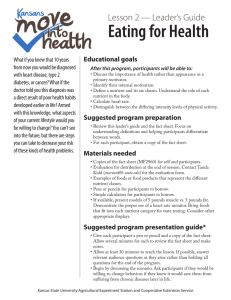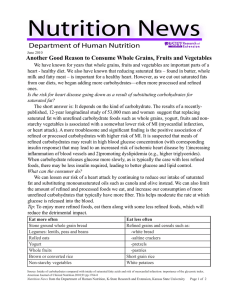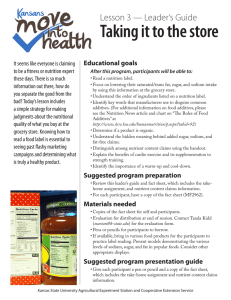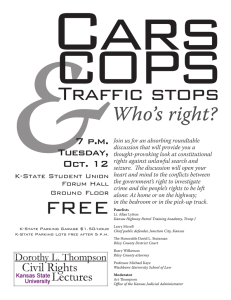Saving Cents on Food Makes Good Sense
advertisement
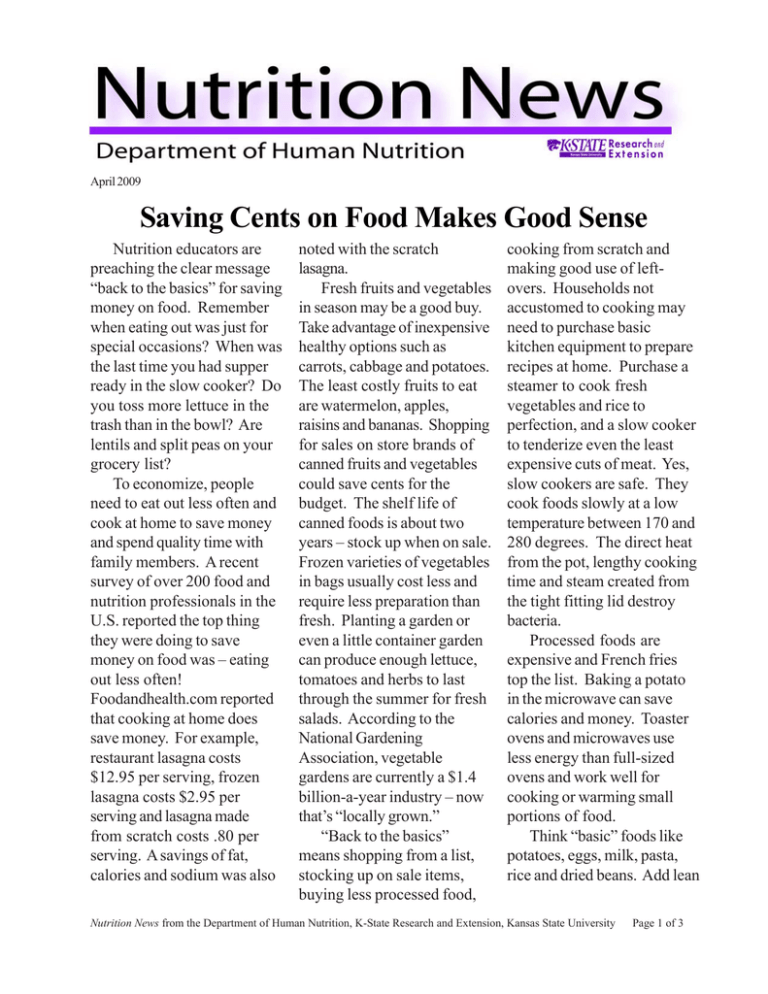
April 2009 Saving Cents on Food Makes Good Sense Nutrition educators are preaching the clear message “back to the basics” for saving money on food. Remember when eating out was just for special occasions? When was the last time you had supper ready in the slow cooker? Do you toss more lettuce in the trash than in the bowl? Are lentils and split peas on your grocery list? To economize, people need to eat out less often and cook at home to save money and spend quality time with family members. A recent survey of over 200 food and nutrition professionals in the U.S. reported the top thing they were doing to save money on food was – eating out less often! Foodandhealth.com reported that cooking at home does save money. For example, restaurant lasagna costs $12.95 per serving, frozen lasagna costs $2.95 per serving and lasagna made from scratch costs .80 per serving. A savings of fat, calories and sodium was also noted with the scratch lasagna. Fresh fruits and vegetables in season may be a good buy. Take advantage of inexpensive healthy options such as carrots, cabbage and potatoes. The least costly fruits to eat are watermelon, apples, raisins and bananas. Shopping for sales on store brands of canned fruits and vegetables could save cents for the budget. The shelf life of canned foods is about two years – stock up when on sale. Frozen varieties of vegetables in bags usually cost less and require less preparation than fresh. Planting a garden or even a little container garden can produce enough lettuce, tomatoes and herbs to last through the summer for fresh salads. According to the National Gardening Association, vegetable gardens are currently a $1.4 billion-a-year industry – now that’s “locally grown.” “Back to the basics” means shopping from a list, stocking up on sale items, buying less processed food, cooking from scratch and making good use of leftovers. Households not accustomed to cooking may need to purchase basic kitchen equipment to prepare recipes at home. Purchase a steamer to cook fresh vegetables and rice to perfection, and a slow cooker to tenderize even the least expensive cuts of meat. Yes, slow cookers are safe. They cook foods slowly at a low temperature between 170 and 280 degrees. The direct heat from the pot, lengthy cooking time and steam created from the tight fitting lid destroy bacteria. Processed foods are expensive and French fries top the list. Baking a potato in the microwave can save calories and money. Toaster ovens and microwaves use less energy than full-sized ovens and work well for cooking or warming small portions of food. Think “basic” foods like potatoes, eggs, milk, pasta, rice and dried beans. Add lean Nutrition News from the Department of Human Nutrition, K-State Research and Extension, Kansas State University Page 1 of 3 Nutrition News from the Department of Human Nutrition, K-State Research and Extension, Kansas State University Page 2 of 3 ground beef, chicken and turkey to casseroles and other dishes as a “side” and not as the center of the plate. Buying fewer chips, soda, cookies, crackers and convenience meals at the store saves cents. The least processed foods are generally the least expensive foods at the store. Not convinced? The chart below shows what $13.00 can buy when a shopper considers more than just getting that next snack “fix”. Here is an example of stretching the snack food dollars -- shopping with your wallet AND your palate in mind! For about $13.00, OR that s ame $13.00 you could buy could buy 1 pound bag cookies 4 bananas 10- ounce bag chips 3 apples 2 liter soda 3 pears 1/2 gallon ice cream 3 oranges 12 broccoli stems 10 long carrots 1 pound raisins 1 jar applesauce 1 large can frozen orange juice concentrate and either a jar of peanut butter or ranch dressing for a dip Which “snack group” has more vitamin A and C, more nutrition, more fiber, more servings and is more colorful? Which has more calories, more saturated fat, more trans fat, more sugar and more cholesterol? Which snack group would you choose for the price? Food waste is money down the drain. Watch expiration dates and sell by dates and keep a list of what’s in the refrigerator, freezer and pantry. Make better use of left-overs or freeze half the recipe. Combining left-over vegetables with a pot of rice or pasta is a quick way to prepare a healthy entrée and reduce food waste. Now is the time to bring back the basics - those often forgotten nutritious and affordable foods. The chart on the next page shows the least expensive fruits and vegetables to eat. References: http://www.fruitandveggiesmorematters.org, National Online Survey by Insight Express for Parade, http:// foodandhealth.com, http://www.ers.usda.gov/publications/aib790/aib790f.pdf Nutrition News from the Department of Human Nutrition, K-State Research and Extension, Kansas State University The le as t e xpe ns ive ve ge table s to e at The le as t e xpe ns ive fruits to e at Cabbage Watermelon Potatoes Apples Whole carrots Raisins Radishes Bananas Canned green beans Grapefruit O nions Papayas Cucumbers Applesauce Celery N ectarines Mustard greens Pears Bell peppers Peaches Page 3 of 3 Lettuce Canned tomatoes Canned potatoes Canned corn Canned carrots Frozen green beans Cauliflower K ale Canned peas Sweet potatoes Broccoli For more information about healthy eating, contact your local extension office. The Food Assistance Program can help people of all ages with low income buy nutritious foods for a better diet. To find out more, call toll-free 1-888-369-4777. Contents of this publication may be freely reproduced for educational purposes. All other rights reserved. In each case, credit Kathy Walsten, BS, Nutrition Educator, Family Nutrition Program, Department of Human Nutrition; Kansas State University; Saving Cents on Food Makes Good Sense. April 2009. K-State Research and Extension is a short name for the Kansas State University Agricultural Experiment Station and Cooperative Extension Service, a program designed to generate and distribute useful knowledge for the well-being of Kansans. Supported by county, state, federal and private funds, the program has county Extension offices, experiment fields, area Extension offices and regional research centers statewide. Its headquarters is on the K-State campus, Manhattan. Brand names appearing in this publication are for product identification purposes only. No endorsement is intended, nor is criticism implied of similar products not mentioned. Kansas State University Agricultural Experiment Station and Cooperative Extension Service, Manhattan, Kansas. Kansas State University is an equal opportunity provider and employer. Kansas State University, County Extension Councils, Extension Districts, and the U.S. Department of Agriculture cooperating.
